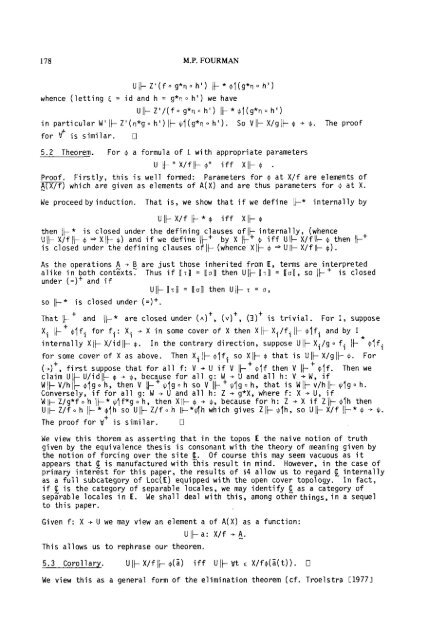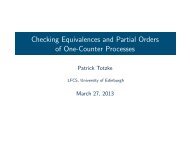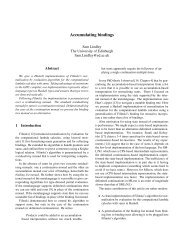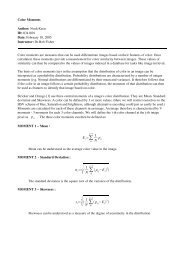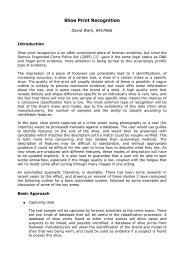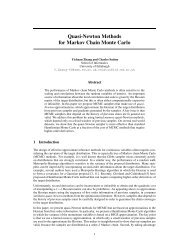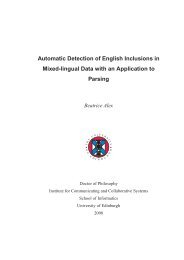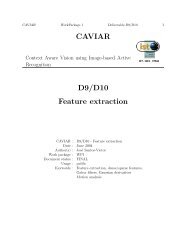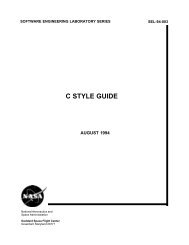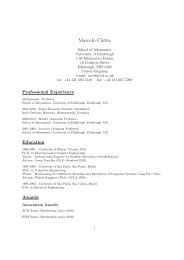Continuous Truth I Non-constructive Objects
Continuous Truth I Non-constructive Objects
Continuous Truth I Non-constructive Objects
You also want an ePaper? Increase the reach of your titles
YUMPU automatically turns print PDFs into web optimized ePapers that Google loves.
178 M.P. FOURMAN<br />
Uk- Z'(f0 g*no h') It * $1(g*no h')<br />
whence (letting 5 = id and h = g*n 0 h') we have<br />
U Z'/( f 0 g*n 0 h' It * $1 (g*n 0 h')<br />
in particularW'IkZ'(n*goh')lkJil(g*qoh').<br />
I<br />
for V is similar. 0<br />
5.2 Theorem.<br />
So VlkX/g/k~-t$. The proof<br />
For Q a formula of L with appropriate parameters<br />
U IF'' X/flk Q" iff xlk Q .<br />
Proof. Firstly, this is well formed: Parameters for Q at X/f are elements of<br />
m) which are given as elements of A(X) and are thus parameters for $ at X.<br />
We proceed by induction.<br />
That is, we show that if we define It* internally by<br />
-<br />
Ulk X/f It * Q iff X l t Q<br />
X\k $) and if we define \I+<br />
then it* is closed under the defining clauses oflk internally, (whence<br />
UIk X/f 1 @<br />
by X It+ $ iff Ulc X/f Ik @ then \kt<br />
is closed under the defining clauses of (whence Xlk Q *VIE X/flt- Q).<br />
As the operations A + B are just those inherited from E,<br />
alike in both contgxts:<br />
under (=)+ and if<br />
so IF* is closed under (=)+<br />
That It + and<br />
terms are interpreted<br />
Thus if [TI = Uo] then UlkU-rl = Dull, so 1' is closed<br />
Xi 11'$Ifi for fi: Xi + X in some cover of X then X I 1 Xi/fi<br />
internally Xik X/idlk $. In the contrary direction, suppose Ulk Xi/g 0 fi IF* $Ifi<br />
for some cover of X as above. Then Xi $Ifi so Xlk Q that is Ulk X/g Q. For<br />
(+)+, first suppose that for all f: V + U if V I--+~lf then V Ik+~lf. Then we<br />
claim UI U/idlk @ + I$, because for all g: W + U and all h: V +W, if<br />
W V/h IF @1g 0 h, then V It+ $lg 0 h so V IF + $19 0 h, that is W v/h Jilg 0 h.<br />
Conversely, if for all g: W + U and all h: Z + g*X, where f: X + U, if<br />
WIE Z/g*f o h \I* $lf*g 0 h, then XIk @ + $, because for h: Z -t X if Z\k $lh then<br />
U l t Z/f 0 h It-* $lh so Ulk Z/f 0 h It-*Jl?h which gives Zlk $Ih, so Ulk X/f I/-* Q + Ji.<br />
The proof for W+<br />
is similar.<br />
Ulk U ~ l l = Uol then UIk T = a,<br />
\I-* are closed under (A)', (v)', (3.)' is trivial. For I, suppose<br />
We view this thorem as asserting that in the topos E the naive notion of truth<br />
given by the equivalence thesis is consonant with the theory of meaning given by<br />
the notion of forcing over the site &. Of course this may seem vacuous as it<br />
appears that B is manufactured with this result in mind. However, in the case of<br />
primary interkt for this paper, the results of 84 allow us to regard (I internally<br />
as a full subcategory of Loc(E) equipped with the open cover topology. In fact,<br />
if Q is the category of separable locales, we may identify (I as a category of<br />
sepgrable locales in E. We shall deal with this, among other things, in a sequel<br />
to this paper.<br />
Given f: X -f U we may view an element a of A(X) as a function:<br />
U It a: X/f + A,.<br />
This allows us to rephrase our theorem.<br />
5.3 Corollary. ulkX/flk $(a) iff Ulk~t E X/f@(a[t)). 0<br />
0<br />
$Ifi and by I<br />
We view this as a general form of the elimination theorem (cf. Troelstra C19771


